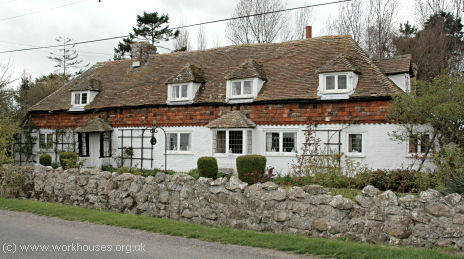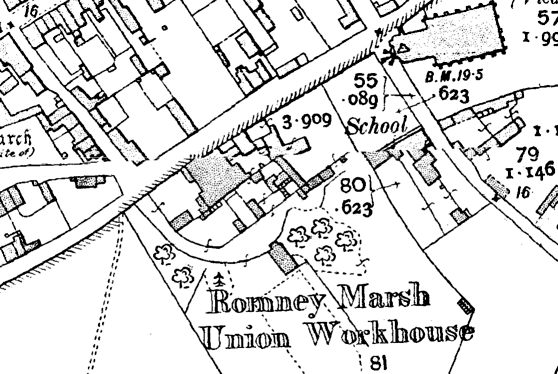Romney Marsh, Kent
Up to 1834
A parliamentary report of 1777 recorded a parish workhouse in operation at Lydd for up to 40 inmates.
A pre-1834 workhouse was located at Crockley Green, New Romney. Newchurch had a poorhouse to the south-west of the village at Norwood, now the site of Norwood cottage. A workhouse operated on Mill Road in Dymchurch from 1791 to 1834.
A house on St Mary's Road, St Mary in the Marsh, is also said to have been used as a local poor house.

St Mary In The Marsh former poorhouse?, 2005.
© Peter Higginbotham.
After 1834
Romney Marsh Poor Law Union officially came into existence on 14th November 1835. Its operation was overseen by an elected Board of Guardians, one representing each of its 18 constituent parishes as listed below:
County of Kent: Blackmanstone, Brenzett, Brookland, Burmarsh, Dymechurch [Dymchurch], Eastbridge, Fairfield, Hope All Saints, Ivy Church [Ivychurch], Lydd, St Mary's [in the Marsh], Midley, New Church [Newchurch], New Romney, Old Romney, Orgarswick, Snargate, Snave, West Hythe.
The population falling within the Union at the 1831 census had been 4,859 — with parishes ranging in size from from Blackmanstone (population 5) to Lydd (1,357). The average annual poor-rate expenditure for the period 1833-5 had been £6,998 or £1.8s.10d. per head of the population.
Initially, three existing parish workhouses were retained by the union: at Lydd, for the temporary reception of the able-bodied; at Brookland for the aged and infirm; and at New Romney for the children. Eventually, a large house on Church Road, New Romney was purchased and around £1000 spent on its conversion for use as the union workhouse. The workhouse location and layout are shown on the 1907 map below:

Romney Marsh site, 1907.
In 1885, an inmate of the workhouse named Martha Southwell, who was thought to have died, regained consciousness as her funeral was taking place. Her coffin had almost reached the cemetery when the bearers heard knockings from inside. They dropped the coffin, which broke into pieces and out stepped the 'corpse'. Very indignant, she walked back to the workhouse and resumed her work in the laundry, thereafter using the lid of her coffin as an ironing board. She survived another fifty years, dying in 1935 at the age of 88.
From 1904, to protect them from disadvantage in later life, the birth certificates for those born in the workhouse gave its address just as Buttfield House, New Romney.
The workhouse buildings are believed to have been demolished in the 1950s and housing now stands on the site.
Children's Home
By 1913, the Romney Marsh Union had established a children's home known as 'Glan Morfa' on Spitalfield Lane, New Romney.
Staff
Inmates
Records
Note: many repositories impose a closure period of up to 100 years for records identifying individuals. Before travelling a long distance, always check that the records you want to consult will be available.
- Kent History and Library Centre, James Whatman Way, Maidstone, Kent (from Spring 2012). Holdings include: Guardians' minutes (1835-1930); Ledger (1835-1930, with gaps); Births (1836-1930); Deaths (1836-1931); Admissions and discharges (1911-26); etc.
Bibliography
- Higginbotham, Peter Workhouses of London and the South East (2019)
Links
- Dymchurch Heritage Group has records, deeds of purchase and sale plus many stories about the Dymchurch workhouse.
Unless otherwise indicated, this page () is copyright Peter Higginbotham. Contents may not be reproduced without permission.


